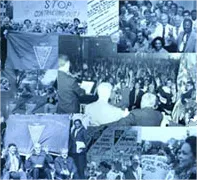The History of Local 375

The Civil Service Technical Guild's story began in New York in the 1920's and 30's, when huge public works were being designed and built. In 1929, the year of the great stock market crash, a new organization, the Union of Technical Men, organized a protest rally of about 150 Engineers at City Hall. Enraged, the Transportation Commissioner laid off every man, and only permitted them to return to work in lower titles. But the spirit of Unionism would not be stilled. In 1933, remaining Technical Men helped found the new Federation of Architects, Engineers, Chemists & Technicians. Including private industry members, it agitated for better wages in New Deal public works projects like the WPA.
In 1934, Fiorello LaGuadia took office as Mayor of New York City. Without warning, on February 14 of that year, he laid off 5,000 of the City's 6,000 municipal Engineers. Later on, a new clause was inserted into the City Charter, which said that all public works projects estimated to cost over $100,000 would be farmed out to private design firms. The consultants' lobby, supported by LaGuardia, had fashioned a poison pill for the battered remnants of the civil service professional corps.
But Engineers led by Henry "Hank" Cunningham, William Elliot, and George Ellenoff formed an organizing committee. A meeting was called for February 7, 1937 in the offices of Frank Prial, editor of The Chief. At that meeting, the Civil Service Technical Guild was founded. It declared as its mission the following:The economic betterment of Civil Service Technical Employees; to prevent the awarding of the work to private concerns; to aid, strengthen, and prevent violations of Civil Service Laws; to support and advocate all laws tending to raise the standards of Civil Service generally.
Join As A Member
Protect Your Rights And Benefits!
We want you to be part of New York City’s largest public employee union, with about 150,000 members and 50,000 retirees. Do you work in a DC 37 title? Are you paying dues without being a member? Then sign up today for a voice in your union and your workplace. Join electronically to become a Local 375, DC 37 member and sign up to receive the latest union news.
